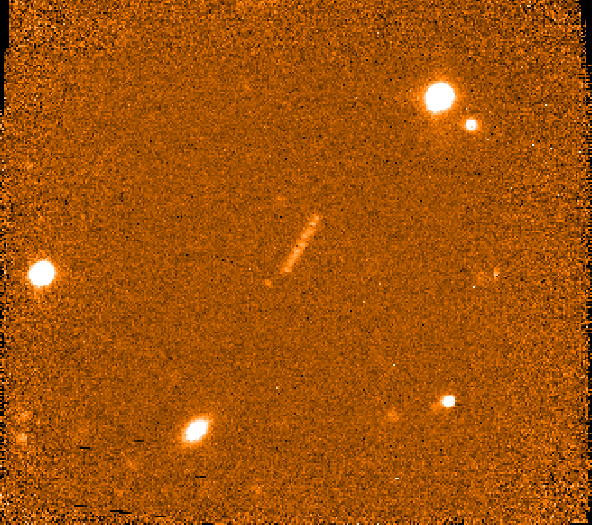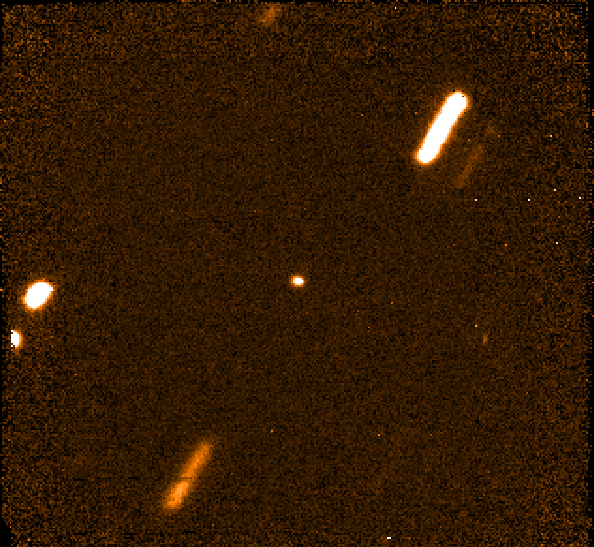
The Need for a Kuiper Belt.
Although exactly who suggested it first is slightly controversial, around the late 1940's and early 1950's J. Edgeworth and G. Kuiper both suggested that there was no obvious reason why the solar system should suddenly stop when it got to Pluto and that there ought to be a ring of small icy bodies somewhere out in the region around Neptune and Pluto. The problem was that with the technology then available there was no hope of seeing such tiny objects so the subject remained one of only theoretical interest for a number of years.
Apart from the philosophical nicety of having the Solar System fade gradually away into deep space the "need" for a belt of small icy objects beyond Neptune began to be felt in the 1980's when caclulations showed that there were too many short period comets trapped in the inner solar sytem to be explained by captures of long period comets from the much more distant Oort Cloud where most comets were expected to be found. The problem was that these Oort cloud comets are only captured if they fly close to the giant planet Jupiter and if comets were coming into the planetary region at all kinds of angles the likelihood of close encounters between the comets and Jupiter was too small to explain the number of captured comets. However if there were a belt of comet-like objects in orbits close to the plane of the planets then, if one entered the inner solar system, it would at least cross Jupiter's orbit about about the right "height" rather than flying over the top or underneath. Such an object would be much more likely to be captured into a short period orbit. A rather unpleasant practical example of this effect is that you see more dead cats than birds on the roads despite the fact that there are more birds than cats. Most birds cross the road above the plane in which the cars move and so are unlikely to have close encounter. The cats, confined to 2 dimensions, run a much bigger risk of encoutering a vehicle each time they cross a road.
The first hint of the existence of icy bodies in the outer solar system came with the discovery of minor planet 2060 Chiron beyond Saturn. Chiron was quite big, about 200km across, and was thought by some to be just the first example of a new outer-asteroid belt. However over the next 15 years no other object in this region was discovered and when it was found in the mid 1980's that Chiron was not in fact an "asteroid" but that it gave off gas and dust to form a coma and tail like a comet, opinion switched to the view that Chiron must just be a large comet nucleus that was somehow trapped in this unusual orbit. Chiron's orbit is unstable because it can have close encounters with Saturn and one day its orbit will be modified in such a way that it either gets thrown back out into deep space or enters the inner solar system in which case it will become a REALLY bright comet.
Then, 1992, everything changed. In Janaury of that year the Spacewatch asteroid search team in Arizona discovered another object, originally called 1992AD but soon named 5145 Pholus, in an orbit rather like that of Chiron. This was where I came in, and it shows just how luck can be involved in science. I wanted to determine ths size of the new object using the same methods used for Earth grazing asteroids and so tried to obtain some thermal infrared observations of Pholus from UKIRT. In fact I failed to get the data I wanted because we were unable to locate the target accurately enough with the instruments available at the time, but during the attempt we took some near-infrared measurements and found that, unlike Chiron, which is pretty much grey all over, Pholus was very red. The same discovery was made about the same time by at least three other groups who were observing in the optical region rather than in the infrared. It was soon clear that Pholus was the reddest object in the solar system!
This got me motivated to look further and I was lucky enough to get one of the UKIRT staff scientists to take an infrared spectrum of Pholus for me a few days later. Spectra are of interest since they can often reveal which atoms or moleules are present in an astronomical object. The observation of Pholus turned up a spectral feature in the 2 micron region of the spectrum which had never been seen before and is probably related to whatever makes Pholus so red. The most likely explanation is that Pholus is covered with organic, (carbon bearing - not alive) molecules which started off as simple ices but got converted into more complex, and more stable, molecules by millions of years of bombardment by cosmic rays.
Since 1992 a number of other Centaurs have been discovered, by early 1999 there were a total of nine known. I've observed most of them trying to find out if they are mostly like Chiron and Pholus is the odd one out, or vice-versa. At the moment it looks as if neither Pholus nor Chiron are typical but that there is a range of colours amongst the different objects, perhaps reflecting a gradual transition of surface colour from red to grey, or grey to red, over time. My collaborators and I (and quite a few other scientists) are still trying to figure out what is going on with these unusual objects. What seems certain however is that the Centaurs have escaped from a region even more distant from the Sun and that they are examples of objects from the Kuiper belt which are evolving inwards towards the Sun under the gravitational influence of the outer planets.
I also observe onjects that are probably in transition from one orbital class to another. An example is 1998 WU24. This is a small object with an elongated orbit like Halley's comet, but unlike the comet it does not seem to have any gas or dust associated with it. Perhaps it is rocky, or perhaps it is a comet nucleus that has either run out of gas or has temporarily stopped being active. When we observed it it was in the inner solar system and so was moving quite quickly. Over 9 minutes it appears as a streak like so..

However by combining our images in the frame of the asteroid we can make it appear to be a point source while all the stars are smeared out. Once we have got all the light from the object into one spot, we can measure how bright it is.

About six months after the Spacewatch team discovered 5145 Pholus, another distant asteroid was discovered by Dave Jewitt and Jane Luu using the University of Hawaii's 88 inch telescope on Mauna Kea, Hawaii. Numbered 1992 QB1, this object was soon found to have a more or less circular orbit beyond Neptune and as such was the first direct confirmation of the existence of the Kuiper belt. Some months later Luu and Jewitt found another similar object called 1993 FW. Since then several other groups have entered the fray and there are now a large number of these objects known. These seem to fall into 3 groups. One group comprises objects which are in orbits that, like Pluto, come close to or cross the orbit of Neptune but are stabilised in these orbits because their orbital period is syncronised with the orbital period of Neptune. These objects, sometimes called Plutinos, are in resonances with Neptune, just like the Trojan asteroids are in resonances with the planet Jupiter. A second group are in more-or-less circular orbits well beyond Neptune. The third group are in very elongated orbits which take them a long way from the Sun and they only approach the Neptune region when they are at the innermost parts of their orbits. You can find out much more about the Kuiper disk on Dave Jewitt's home page or on the pages maintained by the Minor Planets Center in Cambridge, MA.
My interest in the Kuiper belt objects is in their possible relationships to the Centaurs; do they have the same range of colours from red to grey and all shades in between or are they all the same colour? What can this tell us about their chemistry and their history? What has happened out there in the 4.5 billion years since the solar system formed? This is hot topic amongst people interested in these objects with some groups saying that, like the Centaurs, the Kuiper belt objects have wide range of colours and others who say they are just two groups and the reason for the apparent diversity is that these objects are so faint that some of the data published is not all that accurate. Of course this is a good example of how science works and no doubt in a few years we will know the answer one way or the other. If you want some details of the optical-infrared colours of Centaurs click here to see my recent paper on this subject. Also check out my publications list. If you can cope with some other technical stuff click here for an example of how we challenged the published estimate of the rotation period of Kuiper belt object 1993SC and hopefully advanced science slightly in the process. (No doubt even as you read this other scientists are busy challenging some of my results too!).
If you want to read my book on the Kuiper Belt, visit Cambridge University Press' web page or go to my page on my books.
Return to
John Keith Davies
Astronomy Technology Centre, Royal Observatory, Blackford Hill,
Edinburgh, EH9 3HJ
j.davies@roe.ac.uk
tel: (44) 0131 668 8348 /
fax: (44) 0131 662 1668/